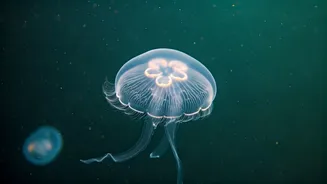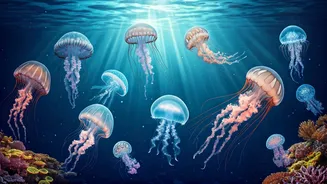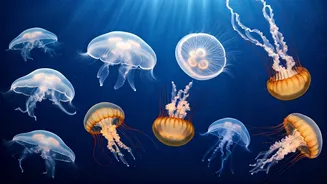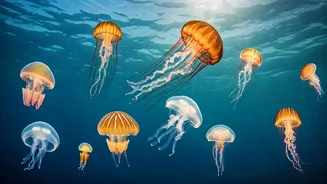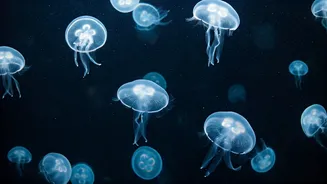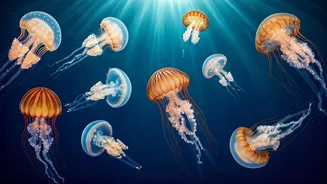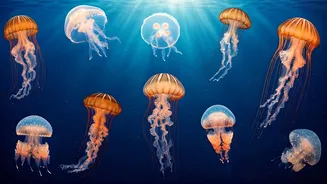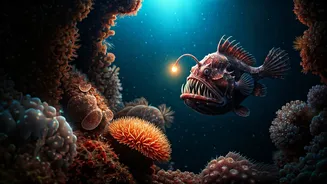Crystal Clear Elegance
The first jellyfish on our list is the Crystal Jellyfish, renowned for its translucent body, a characteristic that gives it its name. This jellyfish is commonly
found in the Pacific Northwest of North America. Its transparency isn't just a visual marvel; it's a practical adaptation. It helps the Crystal Jellyfish avoid predators by blending seamlessly into its surroundings. These jellyfish possess a unique feature: bioluminescent proteins that emit light when disturbed. These proteins, particularly aequorin and green fluorescent protein (GFP), have been instrumental in scientific research, allowing scientists to study cellular processes in unprecedented detail. These jellyfish are small, usually measuring about 2.5 cm in diameter, and they are a vital part of the marine ecosystem, serving as both predators and prey.
Lion's Mane Majesty
The Lion's Mane Jellyfish earns its name from its impressive size and flowing, mane-like tentacles. This behemoth can grow to be one of the largest jellyfish species, with a bell diameter that can exceed 100 feet. The tentacles, which can stretch up to 120 feet long, are used to capture prey, which mainly consists of fish and smaller jellyfish. They are commonly found in colder, northern waters, including the Arctic and North Atlantic Oceans. The Lion's Mane Jellyfish showcases an array of colors, varying from shades of red and orange to brown, reflecting its habitat. Though their sting is not typically fatal to humans, it can be quite painful. These jellyfish play an important role in the marine food web, serving as both predators and food for larger animals like sea turtles and seabirds.
Moon Jelly's Grace
Moon Jellyfish are perhaps one of the most familiar and easily recognizable jellyfish species, known for their translucent, moon-shaped bells. Commonly found in oceans worldwide, these jellyfish are identified by their characteristic four horseshoe-shaped gonads, which are visible through their bell. Their primary diet consists of plankton, which they capture using their tentacles. They drift gracefully through the water, propelled by gentle pulsations of their bell. Moon Jellyfish are relatively harmless to humans, their stings being mild and causing minimal discomfort. These jellyfish are a fundamental part of the marine ecosystem, supporting the food chain. Their ability to reproduce both sexually and asexually allows for rapid population growth, contributing to their widespread presence in different marine environments.
Box Jelly's Danger
Box Jellyfish are known for their cube-shaped bell, a defining feature, and are considered some of the most venomous creatures in the ocean. Found primarily in tropical and subtropical waters, particularly in the Indo-Pacific region, they are highly feared due to their potent venom. The venom of a box jellyfish can cause severe pain, cardiac arrest, and even death within minutes. These jellyfish possess complex eyes, capable of seeing, and they actively hunt their prey, usually small fish and crustaceans. Box Jellyfish are highly capable swimmers, moving through the water with remarkable speed and agility. Their unique hunting abilities and potent venom make them a significant threat, highlighting the complex nature of marine ecosystems and the dangers they can hold.
Flower Hat's Beauty
The Flower Hat Jellyfish, recognized for its vibrant colors and intricate patterns, adds beauty to the ocean. These jellyfish, found in the Indo-Pacific region, have a bell that can be adorned with stripes and spots, which resemble the petals of a flower. Their tentacles are typically short and delicate, used to capture small prey. Flower Hat Jellyfish are relatively small, usually reaching up to 15 cm in diameter. They are not known to be dangerous to humans, and their gentle appearance belies their active hunting lifestyle. They are a fascinating species, contributing to the biodiversity of their ecosystem. The Flower Hat Jellyfish contributes to the complex beauty and delicate balance found in the diverse marine habitats it calls home.
Sea Nettle's Sting
Sea Nettles are another type of jellyfish, recognized for their stinging cells, which are used to capture prey. Commonly found in coastal waters around the world, these jellyfish have a bell with long, trailing tentacles. The sting of a Sea Nettle can be quite painful to humans, causing skin irritation and inflammation. Sea Nettles are voracious predators, feeding on a wide variety of plankton, small fish, and other jellyfish. Their size varies, but they can reach up to a meter in length, including their tentacles. These jellyfish play a significant role in their marine ecosystems, both as predators and as a food source for other animals. Their presence helps maintain the balance of the food chain.
By-the-Wind Sailor
The By-the-Wind Sailor, or Velella velella, is a unique type of jellyfish that floats on the surface of the ocean. This species is easily recognizable by its small, blue, sail-like structure that helps it catch the wind, allowing it to move across the water's surface. Found in the open ocean, these jellyfish are often seen in large groups, sometimes washing up on beaches in massive numbers. They feed on plankton, and their stings are typically harmless to humans. Their widespread presence and ability to drift with the wind make them an intriguing part of the marine ecosystem. The By-the-Wind Sailor is a testament to the diverse ways life has adapted to thrive in different environments, contributing to the open ocean's biodiversity.
Comb Jelly's Glow
Comb Jellies, or ctenophores, are similar to jellyfish in appearance but are a separate group of marine invertebrates. Unlike true jellyfish, they do not have stinging cells. Instead, they use rows of cilia, which are small, hair-like structures, to move through the water. Many Comb Jelly species are bioluminescent, producing a mesmerizing glow, especially when disturbed. These creatures are found in oceans worldwide and vary greatly in size and shape. They play a critical role in the marine food web, consuming plankton and serving as food for larger animals. Their unique features, including their iridescent light displays, contribute to the underwater beauty and complexity of marine life.
Portuguese Man o' War
The Portuguese Man o' War is often mistaken for a jellyfish, but it's actually a siphonophore, a colony of specialized organisms working together. Recognizable for its gas-filled bladder, which helps it float on the surface, this creature is carried by ocean currents and winds. Beneath the float, long tentacles, which can extend up to 50 feet, are armed with stinging cells. The sting from a Portuguese Man o' War can be extremely painful to humans, causing intense pain, welts, and, in rare cases, severe allergic reactions. These creatures are often found in warmer waters around the world. Their sting is a potent reminder of the complex and sometimes dangerous beauty of marine life. They are a fascinating example of cooperative living in the ocean.
Upside-Down Jellyfish
The Upside-Down Jellyfish, or Cassiopea andromeda, stands out due to its unusual habit of resting upside down on the seafloor. Found in shallow, tropical waters, these jellyfish have a bell that faces downward, allowing them to expose symbiotic algae to sunlight. This algae provides the jellyfish with nutrients through photosynthesis. They are often seen in groups, forming vast underwater meadows. The Upside-Down Jellyfish has short tentacles, which it uses to capture small prey. These jellyfish play a role in their ecosystem by providing habitat and food for other marine organisms. Their unique lifestyle shows how diverse and adaptable marine life can be, adding to the beauty of coral reefs and other shallow water habitats.
